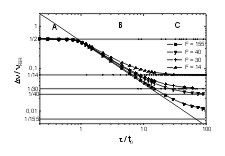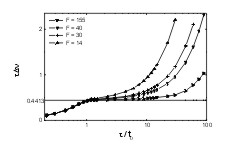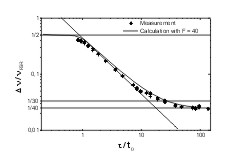|
|
|
|
|
© Stefan Marzenell |
|
The measurement of the spectral width of ultrashort light pulses using a Fabry-Perot interferometer (FPI) is investigated. It is shown, that the measured width critically depends on the pulse properties (such as pulse shape, pulse duration, frequency chirp and wavelength) and on the properties of the FPI (such as the mirror spacing and the mirror reflectivities). |
|||||||||
 |
|||||||||
|
Here the normalized spectral width Dn/nFSR is plotted as a function of the normalized pulse length t/t0 for different values of the finesse F. The solid diagonal line represents the spectral width of Fourier-limited pulses. Using the normalized parameters allows a more general discussion of the results obtained for different values of the pulse length, the finesse and the free spectral range. |
|||||||||
|
As seen in the figure for pulses that are short compared to the Fabry-Perot round-trip time the ratio Dn/nFSR does not depend on the finesse F. If the pulse duration is less than 20% of the round-trip time the pulse is simply reflected at the two surfaces of the Fabry-Perot interferometer. |
|||||||||
|
The time-bandwidth product is calculated by multiplying the spectral width Dn with the corresponding pulse duration t. The dependence of t Dn on the normalized pulse duration (t/t0) is shown below for different values of the finesse F. |
|||||||||
 |
|||||||||
|
The horizontal line is drawn at a value of 0.4413, which is the Fourier limit for t Dn for Gaussian pulses. For short pulses (t/t0 < 1) the values of t Dn are independent of the finesse. The determined value of the time-bandwidth product is smaller than the Fourier limit. For intermediate values of the ratio t/t0 (1 < t/t0 < 3) the value of t Dn is rather accurate, whereas for longer pulses the value is to large. In this case the resolving power of the Fabry-Perot interferometer is too small to resolve the narrow spectrum of the longer pulses. The time-bandwidth product thus increases with increasing pulse length because the spectral pulse width remains constant because it is equal to the value of the resolving power. This result indicates that the range in which the Fabry-Perot interferometer could be used critically depends on the finesse F. |
|||||||||
|
To compare the calculated results with measured data the spectral width of ps pulses from a cw mode-locked Nd:YLF laser was measured for several mirror spacings. The obtained experimental values are shown below. |
|||||||||
 |
|||||||||
|
This figure shows in addition a horizontal line at a ratio of the spectral width to the free spectral range of 1/2, a horizontal line at the resolving power for a finesse of 30 and a horizontal line at the resolving power for a finesse of 40. Furthermore a line indicates the ratio of the spcetral width to the free spectral range as calculated from the product Dn Dt = 0.4413 for a pulse duration of 50 ps and mirror spacings of 0.25 mm to 15.0 mm which provide a ratio of t/t0 from 0.5 to 30. The experimental values are compared with the data of a numerical simulation assuming a finesse of 40. |
|||||||||
|
Further details are available at http://dx.doi.org/10.1007/s003400000370 |
|||||||||
|
[Home] [Research] [Presentations] [Publications] [Links] [etc.] [Contact] |
|||||||||